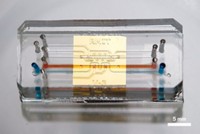Advertisement
Grab your lab coat. Let's get started
Welcome!
Welcome!
Create an account below to get 6 C&EN articles per month, receive newsletters and more - all free.
It seems this is your first time logging in online. Please enter the following information to continue.
As an ACS member you automatically get access to this site. All we need is few more details to create your reading experience.
Not you? Sign in with a different account.
Not you? Sign in with a different account.
ERROR 1
ERROR 1
ERROR 2
ERROR 2
ERROR 2
ERROR 2
ERROR 2
Password and Confirm password must match.
If you have an ACS member number, please enter it here so we can link this account to your membership. (optional)
ERROR 2
ACS values your privacy. By submitting your information, you are gaining access to C&EN and subscribing to our weekly newsletter. We use the information you provide to make your reading experience better, and we will never sell your data to third party members.
Analytical Chemistry
Devices Reveal Hidden Messages
Materials Science: Sensors’ response to surface tension can also differentiate liquids
by Celia Henry Arnaud
August 15, 2011
| A version of this story appeared in
Volume 89, Issue 33

A new type of device that responds to a liquid’s surface tension can be used to reveal hidden messages or to distinguish among different classes of liquids, Harvard University scientists report (J. Am. Chem. Soc., DOI: 10.1021/ja2053013).
The devices provide “a cheap, fast, portable way to perform quality-control tests and diagnose different liquids,” says team leader Joanna Aizenberg, a materials science professor.
They are like “litmus paper for surface tension,” says engineering grad student Ian B. Burgess. “The nice thing about surface tension as opposed to pH is that all liquids have a surface tension,” whereas pH characterizes only aqueous solutions.
To make the surface-tension sensors, the team exposes defect-free, crack-free photonic crystals with uniform pores to an alkylchlorosilane vapor, functionalizing the inner surfaces. They protect the device with a mask and use oxygen plasma etching to erase the surface chemistry from all unprotected areas. They then expose the device to additional rounds of other alkylchlorosilane vapors and plasma etching until the device has the desired pattern of surface chemistry.
The chemistry dictates the extent to which liquids with different surface tensions can wet particular regions of the device. Testing can be done either by immersing the device in a liquid or by swiping a wet cloth across the device. Any part of the pattern that isn’t covered by the liquid then becomes visible.
The Harvard researchers designed one device with the message W-INK. When they immersed the device in 100%, 85%, 78%, or 50% ethanol, different parts of the message were revealed. “We can even distinguish between the same liquid with small differences in concentration,” Aizenberg says.
Another device distinguishes among solvents commonly found in clean rooms. “You could use this to identify an unknown beaker of liquid and then dispose of it properly,” Burgess says. For example, isopropyl alcohol, acetone, and water reveal different numbers of bars on the device. Such a test could be useful for organic solvents for which simple field tests are not available.
The new devices “have potential for authentication and anticounterfeiting applications,” says Sanford A. Asher, a chemistry professor at the University of Pittsburgh who also develops photonic sensors.





Join the conversation
Contact the reporter
Submit a Letter to the Editor for publication
Engage with us on Twitter